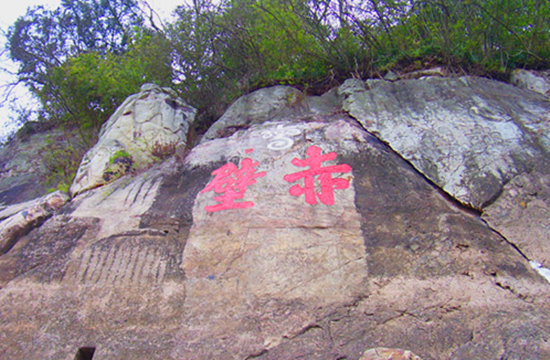Chibi Ancient Battlefield
- Source: Hubei Provincial People's Government
- 09/07/2015 10:24
- 0 744

Chibi (or named Stone Pass) is ruins of the ancient battlefield in the Three Kingdoms period.
Chibi (or named Stone Pass) is ruins of the ancient battlefield in the Three Kingdoms period. It is made up of three mountains, Chibi Mountain, Nanping Mountain, and Jinluan Mountain. Legends say they were written by Zhou Yu of the Three Kingdoms Period. Chibi used to be a battlefield at the time.
In AD 208, Cao Cao led his 500,000 troops pursuing Liu Bei while coveting the Kingdom of Wu in the east, wanting to reunify the whole country. Liu Bei retreated in defeat until to Xiakou by the Yangtze River. He sent Zhuge Liang to persuade Sun Quan, king of the Wu, to ally against Cao Cao. Sun Quan agreed and the allied force defeated Cao Cao with a big fire which burnt the rocks red, hence, the name Chibi, meaning red cliff in Chinese.
The main landscapes are:
Chibi Cliffside Inscriptions: On the cliff bordering river of Chibi Mountain, two characters, "赤壁" are engraved in stone. Each of the two characters is 1.5 meters long and 1.04 meters wide. They are inscribed in Tang Dynasty. In spite of thousand-year wind and rain erosion, and slap of the angry waves, the writing is still legible and complete until now.

On the cliff bordering river of Chibi Mountain, two characters, "赤壁" are engraved in stone.
Yijiang Pavilion: It is situated at River-bordering rock spur, Chibi Mountain. Built in 1936, this pavilion is composed of Ma stone with glazed roof tile at the top, six posts and angles, and a tower-shaped spire. It is so called because Chibi Mountain and Iron Mountain are like the two wings of Kunpeng bird.
Wind-praying Altar: It is also named Wuhou Palace. It is located on Nanping mountaintop which is to the southeast of Chibi Mountain. This palace is built to honor Marquis Zhuge who helps Zhou Yu by setting altar to pray for east wind here. It covers 310 square meters and is divided into two temples. In the inner temple, the vivid whole-body statues of Liu Bei, Guan Yu, Zhang Fei, and Zhuge Liang with flyaway robe girdles are deposited.
The stone statue of Zhou Yu: In a level ground on Chibi rock spur, the stone statue of Zhou Yu, commander of the eastern Wu, one of the Three Kingdoms, is erected. This statue is 9 meters high. It is the biggest stone statue of figure in Hubei province.
Fengchu Hut: It is situated in Jinluan Mountain southeast of Nanping Mountain. According to the legend, during the Chibi War, It was the place where Pang Tong, named Mr. Fengchu, read over book of statics. The posterities build Fengchu Hut here. The present hall of this hut was built in the year 26 of the Qing Emperor, Daoguang (AD 1846). It is used to be a nine-story temple, but now only the top story is preserved. It covers 300 square meters. It is divided into three halls. In the first hall, the whole-body statue of Pangtong is deposited. The second hall is Chibi library. The third one is reception room and restroom.
Chibi Gallery of Steles: It is situated on the right of Wind-praying Altar and behind East-wind Cabinet. The gallery is prepared to construct in 1985 and covers 277 square meters. In May, 1986, it is completed and open to the public. It is a four-sided cloister made up of reinforced concrete, wood, and stone. On the lintel, there are four characters, "赤壁碑廊" ( Chinese name of Chibi Gallery of Steles), inscribed by Li’erchong. In the gallery, 25 steles are set. The stele is combined with the wall. On the stele, there are poems concerning Chibi War made by poets of successive dynasties. These stone inscriptions are made finely in running hand, cursive script, seal character, and Li character with different styles. They can be claimed as immortal works.